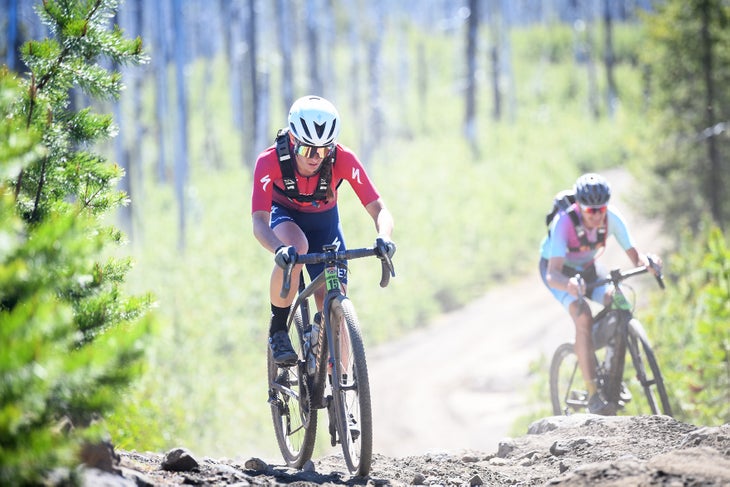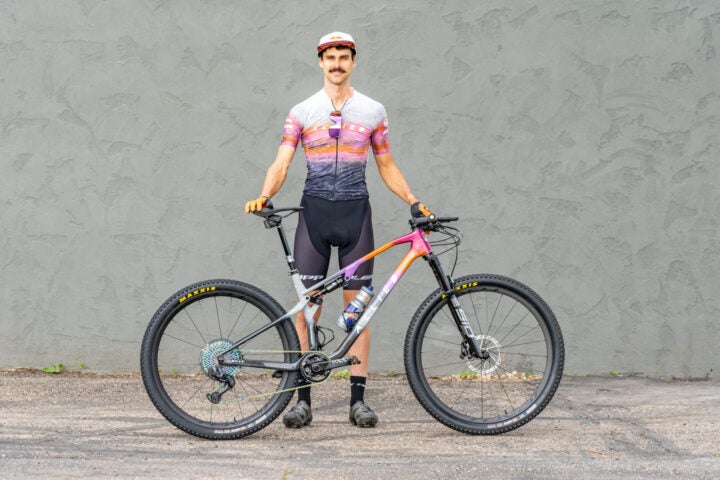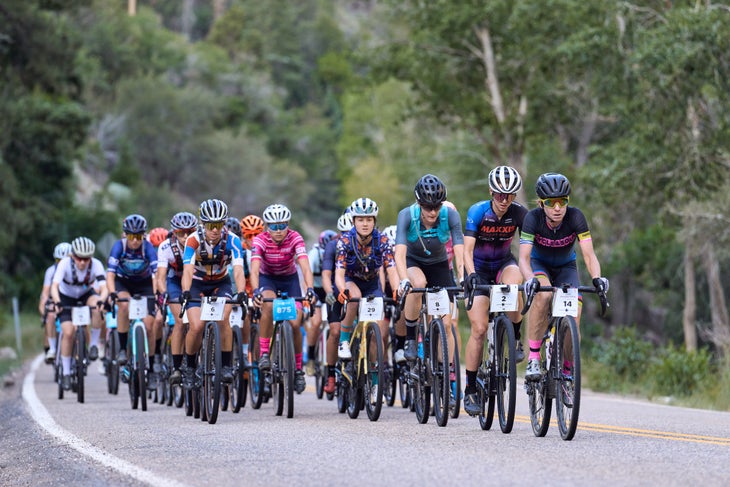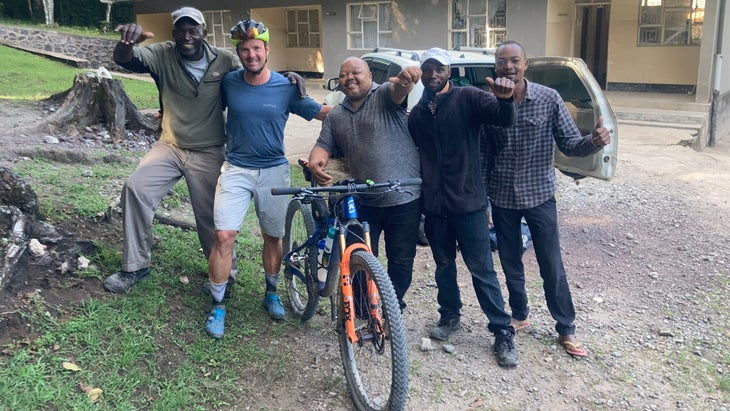Cory Wallace, a 4x Solo 24 Hour MTB World Champion, is racking up a lot of frequent flier miles this year — and spending a lot of money. The pro from Alberta is traveling from the Canadian Rockies to obscure race locations in the United States six times this year for the Life Time Grand Prix series.
While expensive, it’s a calculated decision.
“I normally don’t spend so much on racing,” Wallace, who rides for Kona, says.”With the opportunity for the Life Time Grand Prix though — if I am top ten maybe I can win that money back.”
The Life Time Grand Prix is a six-race series that debuted this year, bringing together 60 of the best off-road riders in North America to race endurance style gravel and cross-country mountain bike events. The race has a prize purse of $250,000 with the overall winners taking home $25,000 and subsequent payout for the top ten.
Among the field of roughly thirty women and thirty men competing in the Grand Prix, however, the discrepancies in finances and support for these riders is particularly vast.
Of these professional racers, some are making six figures, others are breaking even, and some are simply paying to race.
No Rules in Off-Road
For reference, the only discipline of cycling with a guaranteed minimum salary is WorldTour road racing and some Continental road racing. The men’s WorldTour minimum is just under $40,000/year and the women’s WorldTour minimum, starting in 2020, is around $20,000/year.
The UCI has said that by 2023, it aims to create a women’s minimum salary that matches the men’s.
In the gravel and endurance off-road race scene, the rules about around finances are virtually non-existent. At the start of Grand Prix race, you might have a rider making six figures from various sponsors lined up next to one who has paid to travel to the race.
In addition to a wide swath of financial realities, these riders may also have different financial goals related to racing.

Sofia Gomez Villafañe, who is currently sitting in second place second in theGrand Prix series, rides for the Specialized Off-Road Team and has a salary with the capacity for bonuses, as well as all race expenses covered.
In 2016, Gomez Villafañe gave herself a four-year deadline for making a living on cycling. She represented Argentina in the Tokyo Olympics and is now earning a salary from riding that supports her financial goals.
“I’m very business oriented,” Gomez Villafañe says. “Financial security is a really big priority for me in whatever I’m doing.”
The Argentine-American says that while she loves to ride her bike, people shouldn’t mistake it for a hobby.
“It’s not my dream to become a professional bike racer, it’s something that I have accidentally fallen into,” she says. “Cycling is my job — I don’t skip all my family stuff because it’s just fun to get myself into shape all winter in order to race at this level.”
The Athlete-Influencer
For most paid off-road racers, income is drawn from a combination of salary from certain title brands or sponsors, race winnings, bonuses from brands, and money from smaller sponsors. In general, athletes either approach or are approached by brands and will negotiate contracts individually. Some athletes work from a privateer model, piecing together a conglomerate of brands they want to work with.
Other athletes — like Gomez Villafañe — will ride under one umbrella team that provides both a salary and the gear they need.
For a sense of the financial commitment, the Grand Prix series alone requires anywhere from $10,000-$20,000 of cash for travel and entry fees, in addition to up to $30,000 of gear. Understandably, adding a salary to these already high expenses can be a big hurdle for riders.
Riders like Sarah Sturm and Payson McElveen approach their jobs from a unique vantage.
Each of them treat cycling as a full time job but integrate numerous art and media projects to buffer the potential pay-out of their results and their team support.
“If you do one good result a year then that validates everything else, people appreciate your voice, are interested in following your story,” McElveen says “Then it becomes all the other stuff whether it’s a podcast or community outreach that adds value for a sponsor. That’s the real valuable stuff, the stuff that’s different.”
McElveen has taken a real interest in the business side of cycling, leaning into both racing and media to build a brand for himself. Similar to other athletes, McElveen has signed a non-disclosure agreement (NDA) with brands about how much he is paid. He does say that since 2016 he has been able to put a progressively larger percentage of his budget towards income each year.

Despite the hustle, McElveen feels fortunate to be in the gravel and off-road scene.
“Pros are piggybacking on massive events and huge amateur fields — we are in such a unique ecosystem and the non-pro riders are really making this ecosystem healthy. I’m so grateful for this style of event and the opportunity for more creativity from top-level athletes. For me right now, this is a great era to be in.”
Sturm has also built her way into the sport through a combination of stellar results and creative storytelling — and hard work.
For example, Sturm finished fourth at the Leadville 100 MTB race and the next day launched a project called “It’s Supposed to be Fun” at SBT GRVL while some of her competitors chose to race that day.
“I want equal parts focus on racing and projects, like what I did at Steamboat,” Sturm says. “It it gives me the opportunity to make more money, but I do have to work a lot more.”
Sturm is an exemplary model of tailoring her career to meet her needs. She focuses on building value from projects instead of relying on race bonuses. She hopes her approach can serve as a template — and that she can serve as a role model — for what is possible in the sport.
“We need a network of women that are safe to talk to,” Sturm says. “There is a limited amount of resources, but at the same time there is plenty for women to be compensated for what they do. It takes all of us working together to make some bare minimum requests for the work that we do in representing brands we trust and ride for.”
You’re Worth What you Sign
A topic that comes up often when speaking to athletes about salary and finances is a need for greater transparency. Particularly, the NDAs eliminate some of the leverage that athletes could have in negotiating their contracts and receiving more equitable pay.
Interestingly, each of the professional off-road racers we spoke with have signed into their contract that they cannot disclose how much money they are making. Some riders think this is due to the fact that they are paid embarrassingly little for the work they do. Other racers think they are not allowed to disclose this information because they may make disproportionately more than their competitors.
Maude Farrell, who sits in 12th in the Grand Prix, works full time at Rivian, an electric vehicle company. She started racing at a professional level in 2021; however, she is funding her own journey.
“This is definitely a very self supported endeavor,” Farrell says. “I am fortunate that I make a very healthy salary in my work outside of cycling. Cycling has always been a side gig or side hustle. My goal for 2022 was to break even and to cover all of my expenses. I have not achieved that, it costs me about $1000-$1500 per race. I do have a number of sponsors who have been hugely helpful in terms of equipment, but I pay for all of my own maintenance and most of my own travel. It’s pretty much self supported.”

Nevertheless, while Farrell has risen to the top of the off-road race scene in her short time racing, she’s chosen to continue working and not pursue a full time career in cycling — for the very reasons she sees as limiting to other athletes.
“In picking up cycling, I realized I had a particular talent and I was really good. I wanted to see how far I could go with this, I want to see what’s possible, I want to see how good I could possibly be while taking little to few risks,” she says.
“People have told me that I could do this full time, but I don’t want to. For me it’s too much riding on results for too little security — and some of that is knowing how little women make in this sport. For what women are making, I look at that and I don’t want it. I want to keep my job and keep the sort of career experience I can rely on.”
Farrell says that contracts hold weight and they determine an athlete’s value in the sport. With more transparency, professional racers could benefit by having more numbers associated with their value to a brand as well as their competitors’ value.
“Everything under the sun is a negotiation, you owe nothing and everything can be negotiated,” Farrell says. “We can’t fall for the concept of ‘race to the bottom’ — the desperation is not working. Instead of leveraging, many women just settle.”
Even Gomez Villafañe, in a very different situation than Farrell, knows that her signature on a contract is a silent affirmation of her worth.
“At the end of the day, you’re worth the contract that you sign,” she says. “That’s been a pretty tough cookie I’ve had to swallow, understanding that at the end of the day it’s business. You are an asset to a company and you have to sell yourself to get the most you feel you’re worth. You need to know how to advocate for yourself and negotiate.”
Gratitude, Nonetheless
Many professional athletes at the top of the pack live in a dichotomy of loving each day they have the opportunity to train, race, and travel, while acknowledging that it is really tough to navigate such a variable and secretive space.
Unlike many sports that have more of a guidebook or a path to success, off-road cycling follows a tangled web of different opinions, experiences, and compensation. The discipline of gravel is growing rapidly; mass participation events like those in the Grand Prix are selling out in minutes with thousands of racers. With this growth comes an admiration for the folks at the front. Kids and adults look to these racers with hope that they too could compete at this level.
The results list and Instagram posts don’t tell the full story, though.

Behind the call-ups and podium pictures each athlete is navigating a financial world filled with secrets, inconsistencies, and often empty promises. While some athletes have capitalized on the actively growing moment, others feel disillusioned by the world they dreamed of and worked so hard for. Of course, the love for the sport is shared, but it is not without an incredibly tricky undertone of financial disparity, and, of course, opportunity for growth.
For Wallace, the Canadian, the sacrifice is worth the struggle. Although he has a monthly stipend for expenses and salary from Kona, he still chooses to race and train in less expensive countries to keep costs down.
“Between myself and Kona, we can usually make it work,” he says. “If I need to, I can go back to chainsaw work in the bush country for a month or two for work — I’m not going to not do a race because of the finances. I do have to make the most economic decisions too, though.”
“Bike racing isn’t the NHL or anything, we do it because we love it. Just the fact we can call ourselves professional bike racers and not have to go to a 9-5 job is pretty special. The lifestyle it provides is pretty tough to match. We should be grateful for that. I don’t think any of us are racing to get rich, we are just racing so we can do it, because we love it.”